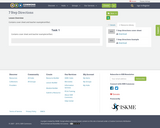
Contains cover sheet and teacher example/artifact.
- Subject:
- Elementary Education
- Material Type:
- Lesson Plan
- Author:
- Johanna Richards
- Date Added:
- 05/22/2019

Contains cover sheet and teacher example/artifact.
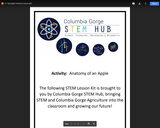
In this place-based lesson, students will dissect an apple fruit to learn more about its different parts. Includes activity instructions, extension activities, songs and rhymes, anatomy of an apple student worksheet, and sink or float student worksheet.
NGSS: K-ESS3-1, 1-LS1-1
Time: 30 minutes
Materials: "Apples Grow on Trees" or other book about apples, knife, cutting board, at least three apples, apple parts tray, and apple dissection worksheet.
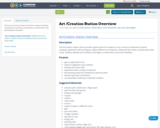
This is an overview of the art/creation station including the purpose, materials, questioning, considerations and photographic examples.

Kindergarten

Contains cover sheet for Because tool
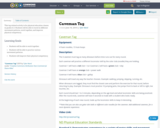
This tag related activity is for physical education classes in grades k-2. Students will be able to travel in different movement patterns, work together, and improve physical competency.
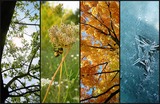
This sequence of instruction was developed in the Growing Elementary Science Project to help elementary teachers who were working remotely. We developed a short storyline that ties together a few sessions to help explore a specific concept. We tried to include some activities that honored and included the student’s family and experience, and some that included the potential for ELA learning goals. Students view a couple of videos and record what they notice and wonder about how plants change as seasons change. Students take a walk with family members to search for evidence of changes due to weather in their neighborhoods. It is part of ClimeTime - a collaboration among all nine Educational Service Districts (ESDs) in Washington and many Community Partners to provide programs for science teacher training around Next Generation Science Standards (NGSS) and climate science, thanks to grant money made available to the Office of the Superintendent of Public Instruction (OSPI) by Governor Inslee.

Contains tool overview and student work sample
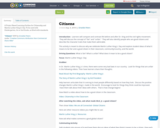
A Project Based Learning Outline for Citizenship and Martin Luther King Jr. Day. To be used with Kindergarten, 1st or 2nd Grade, as fitted with standards.

This project helps children think about the correlation colors have with moods. There are multiple activities involved to engage the students in this lesson and prompt them to create their own ideas about the effects colors may have on moods.

Este curso busca resignificar los prejuicios de género que se encuentran en el tema del color. Está enfocado en alumnos de kínder en un rango de edades de los 4 a los 6, con actividades creativas e interactivas que buscan tener como resultado la desmitificación de que los colores (principalmente el rosa y el azul) tienen género. Nota: este curso ocupa materiales adicionales como lo son impresiones que se recomienda se tomen en cuenta para la realización del mismo.
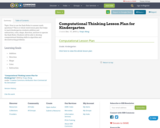
Topic: How to use the Dash Robot to answer math questions?
This is w whole week lesson plan that helps to teach kindergarten students addition and subtraction, color, shape, direction, and how to operate the Dash Robot. Students will be able to develop computational thinking skills in algorithm and deconstructing problems.
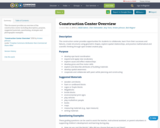
This document provides an overview of the construction center including description, purpose, suggested materials, questioning, strategies and photographic examples.

Welcome to the UnboundEd Mathematics Guide series! These guides are designed to explain what new, high standards for mathematics say about what students should learn in each grade, and what they mean for curriculum and instruction. This guide, the first for Kindergarten, includes three parts. The first part gives a “tour” of the standards for Counting & Cardinality using freely available online resources that you can use or adapt for your class. The second part shows how Counting & Cardinality relate to classification of objects in Kindergarten (K.MD.B). And the third part explains where Counting & Cardinality is situated in the progression of learning in Grades K-2. Throughout all of our guides, we include a large number of sample math problems. We strongly suggest tackling these problems yourself to help best understand the methods and strategies weÂ’re covering, and the potential challenges your students might face.Â
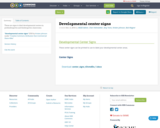
These are signs to label developmental centers in prekindergarten and kindergarten classrooms.
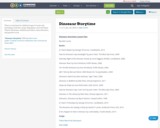
This is a storytime for children's ages 3-6 years old, including a book list, songs, fingerplays, and craft ideas. This for librarians, childcare providers, early educators, and parents to use.
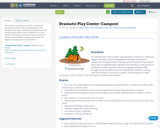
This resource provides an overview of using your dramatic play center with a camping theme. The background, purpose, materials, and question starter prompts are provided. A list of children's literature related to the theme is also part of the document. In addition, downloadable camping center signs and student recording sheets are embedded.

This resources provides information about setting up a flower shop dramatic play center. Resources, question prompts, literature recommendations, picture examples, and downloadable resources are included.
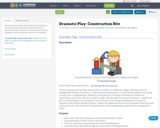
This resources provides information about setting up a construction site dramatic play center. Resources, question prompts, literature recommendations, picture examples, and downloadable resources are included.
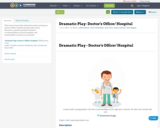
This resources provides information about setting up a doctor's office/ hospital dramatic play center. Resources, question prompts, literature recommendations, picture examples, and downloadable resources are included.